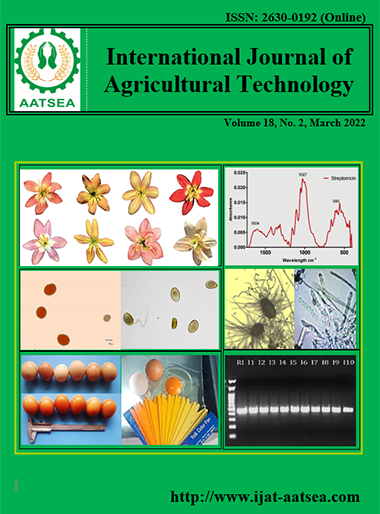Screening of functional activities of Phyllanthus acidus
Main Article Content
Abstract
Phyllanthus acidus is commonly known as gooseberry tree belongs to family Phyllanthaceae which usually grow in tropical areas. In order to establish its functional activities, the antioxidant, phenolic content, antibacterial and molluscicidal activities of the plant were assessed. P. acidus aqueous extract showed 57.14 % radical scavenging activity and contained 29. 41 mg GAE/ g total phenolics. The bacterial inhibitory activity of P. acidus hot water extract against E. coli and S. aureus showed a mean diameter zone of inhibition of 0.58 mm and 5. 19 mm respectively. Whereas, the aqueous extract showed no bacterial inhibitory activity against the bacterial pathogens. Meanwhile, the molluscicidal activity of P. acidus against Pomacea canaliculata (golden apple snail) showed that the extract with a concentration of 1000 ppm had a mean of 2.38 which showed the highest mean mortality rate among the three concentration of aqueous extract tested. Results of the screening of functional activities of the plant extract showed a continuous effort to find a new pharmacological potentiality and plant molluscicides
Article Details

This work is licensed under a Creative Commons Attribution-NonCommercial-NoDerivatives 4.0 International License.
References
Badakshan, M., Jothy, S. L., Latha, L. Y., Chen, Y. and Sasidharan, S. (2012). Antioxidant activity of methanol extracts of different parts of Lantana camara. Asian Pacific Journal of Tropical Biomedicine, 11:960-965.
Dhale, D. A. and Mogle, U. P. (2011). Phytochemical screening and antibacterial screening of Phyllanthus emblica (L.). Science Research Reporter, 1:138-142.
Edoga, H. O., Okwu, D. E. and Mbaebie, B. O. (2005). Phytochemicals constituents of some Nigerian medicinal plants. African Journal of Biotechnology, 7:685-688.
Eguchi, F., Wattanabe, Y., Zhang, J., Miyamoto, K., Yoshimoto, H., Fukuhara, T. and Higaki, M. (1999). Inhibitory effect of hot water extract of Agaricus blazei fruiting bodies (CJ) on hypertension development in spontaneously hypersensitive rats. Journal for Traditional Medicine, 16:201-207.
El-Sherbini, G., Zayed, R. and El-Sherbini, E. (2009). Molluscicidal activity of some Solanum species extracts against the snail Biomphalaria alxandrina. Journal of Parasitology Research, 5.
Francis, G., Kerem, Z., Makkar, H. P. S, and Bekker, K. (2002). The biological actions of saponins in animal system: a review. British Journal of Nutrition, 88:587-605.
Fern, K. (2014). Useful tropical plants database. Retrieved from tropical.theferns.info/viewtropical.php?id=Phyllanthus+acidus
Gerson, S. (2002). The Foundation of Holistic Medical Research, Brewster, New York.
Hadzri, H. M., Yunus, M. A. C., Zhari, S. and Ritwan, F. (2014). The effects of solvent and extraction method on the antioxidant of P. niruri. Jurnal Teknologi Science and Engineering, 68:1-7.
Hodzic, M. Z., Pasalic, H., Memisevic, A., Srabovic, M., Saletovic, M. and Poljakovic, M. (2009). The influence of total phenols content on antioxidant capacity in the whole grain extracts. European Journal of Scientific Research, 28:471-477.
Jagessar, R. C., Marsa, A. and Gomes, G. (2008). Selective antimicrobial properties of Phyllanthus acidus leaf extract against Candida albicans, Escherichia coli and Staphylococcus aureus using stokes disc diffusion, well diffusion, streak plate and a dilution method. Nature and Science, 2:24-38.
Kolak, U., Ozturk, M., Ozgokce, F. and Ulubelen, A. (2006). Norditerpene alkaloids from Delphinium linearilobum and antioxidant activity. Phytochemistry, 67:2170-2175.
Kumari, O., Rao, N. B., Chawhan, L. P. and Rachel, B. (2015). Phyto-chemical analysis of Phyllanthus amarus (Nela usiri), Phyllanthus emblica and Phyllanthus acidus. World Journal Pharmaceutical Research, 1:1457-1462.
Liu, X., Zhaoa, M., Wanga, J., Yangh, B. and Jiang, Y. (2008). Antioxidant activity of methanolic extract of emblica fruit (Phyllanthus emblica L.) from six regions in China. Journal of Food Composition and Analysis, 21:219-228.
Mao, X., Wu., L., Guo, H., Chen, W., Cui, Y., Qi, Q., Li, S. Liang, W., Yang, G., Shao, Y., Zhu, D., She, G., You, Y. and Zhang, L. (2016). The genus Phyllanthus: an ethnopharmacological, phytochemical, and pharmacological review. Evidence-based Complementary and Alternative Medicine, 7584952:36.
Rahman, M., Habiba, R., Hasanb, R., Sayeeda, M. A. and Ranac, S. (2011). Antibacterial, cytotoxic and antioxidant potential of methanolic extract of Phyllanthus acidus L. International Journal of Drug Development & Research, 6.
Rodriguez, L. P., Montero, L. A. F. and Bourzac, F. G. (2006). Pharmacognostic characterization on Phyllanthus amarus Sgumach & Thonn species. Current Trends in Biomedical Engineering and Biosciences, 13.
Satish, S., Raghavendra, M. P. and Ravessha, K. A. (2008). Evaluation of the antibacterial potential of some plants against human pathogenic bacteria. Advances in Biological Research, 4:44-48.
World Health Organization (1965). Molluscicide screening and evaluation. Bullettin of the World Health Organization, 33:567-581.


